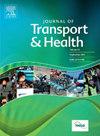Professional drivers’ attitudes towards sedentary behaviour at work and during leisure time: A scoping review
IF 3.3
3区 工程技术
Q2 PUBLIC, ENVIRONMENTAL & OCCUPATIONAL HEALTH
引用次数: 0
Abstract
Introduction
Professional drivers spend prolonged hours sitting, increasing their risk of chronic diseases. However, to date little is known about drivers' attitudes towards sedentariness. The aim of this scoping review was to develop an in-depth understanding of professional drivers’ attitudes to sedentary behaviour during work and leisure time.
Methods
An electronic search of academic databases was conducted including PubMed, Embase, CINAHL, Medline, PsychINFO, and the industry database TRID. Search terms related to key concepts of attitude, sedentary behaviour, work environment, leisure time, and driver mode. Findings were narratively synthesised with key themes identified.
Results
A total of 568 articles were screened with 19 articles included in the final review. Professional drivers highlighted that their work involved high levels of sedentary time and acknowledged this as bad for their health. The drivers believed that both themselves and their workplaces were responsible for their health and subsequently their sedentary exposure at work. Drivers viewed their sedentary exposure at work to be ‘a part of the job’ and unavoidable, some of which related to existing workplace culture beliefs. Work was the biggest factor influencing drivers' attitudes to their sedentary behaviour during leisure time.
Discussion
While professional drivers acknowledged the negative health effects of sedentary behaviours, they viewed the design of the professional driving job as the reason for their sedentary exposure both at work and during their leisure time. Future research endeavours should seek to include professional drivers in the design of interventions to reduce their sedentary time exposure.
职业司机在工作和休闲时间对久坐行为的态度:一项范围审查
职业司机长时间坐着,增加了他们患慢性病的风险。然而,到目前为止,人们对司机对久坐的态度知之甚少。本研究的目的是深入了解职业司机在工作和休闲时间对久坐行为的态度。方法对PubMed、Embase、CINAHL、Medline、PsychINFO、行业数据库TRID等学术数据库进行电子检索。搜索与态度、久坐行为、工作环境、休闲时间和驾驶模式相关的关键概念。研究结果以叙述的方式综合了确定的关键主题。结果共筛选文献568篇,最终纳入文献19篇。职业司机强调,他们的工作需要长时间坐着,并承认这对他们的健康有害。这些司机认为,他们自己和他们的工作场所都要对他们的健康以及随后久坐不动的工作时间负责。司机们认为他们在工作中久坐是“工作的一部分”,是不可避免的,其中一些与现有的职场文化信仰有关。工作是影响司机对闲暇时间久坐行为态度的最大因素。虽然职业司机承认久坐行为对健康的负面影响,但他们认为职业驾驶工作的设计是他们在工作和休闲时间久坐的原因。未来的研究应设法将专业司机纳入干预措施的设计中,以减少他们久坐的时间。
本文章由计算机程序翻译,如有差异,请以英文原文为准。
求助全文
约1分钟内获得全文
求助全文

 求助内容:
求助内容: 应助结果提醒方式:
应助结果提醒方式:


